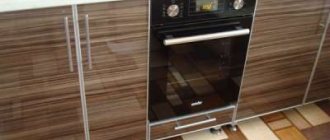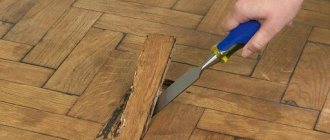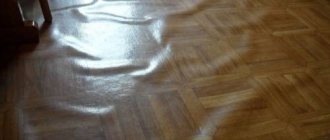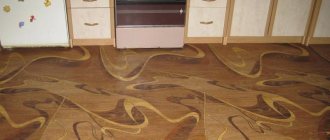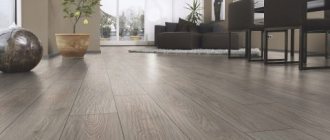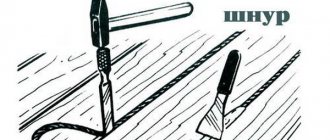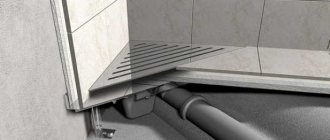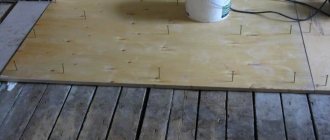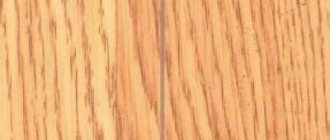Laying a new linoleum covering is always a hassle and problems with glue and alignment of the canvas; you not only have to monitor the joining of the pattern and the parallelism of the edges. Plus, you need to be able to properly smooth out the waves on the linoleum on the floor, otherwise the material, after laying and setting the adhesive base, will turn into an accordion.
After storage curled, it will be difficult to straighten the fabric
Features of linoleum deformation
From time immemorial, the basis of the canvas has been and remains polyvinyl chloride. As the formulation developed, softeners and plasticizers were added to it, but the PVC base remained even in the most modern models of homogeneous and heterogeneous types. The polymer has excellent decorative and performance qualities; it is easy to spread and smooth on the floor before installation.
Everything would be fine if not for a couple of problems associated with the technology of its production and storage:
- The hot PVC sheet is rolled out on rollers, a pattern and varnish are applied, cooled and rolled into a roll with a diameter of several tens of centimeters. Finally, the material “freezes” in a folded state, so there are always waves on new linoleum, which are difficult to smooth out, but still possible;
- It is worse if the linoleum covering was stored rolled up for a long time. The facial layers stretch, and on the back side they shrink and thicken. Such a fabric could be smoothed out if PVC, like any plastic, did not age.
“Dried”, having lost most of the plasticizer, linoleum turns from a plastic and soft floor covering into something like cardboard.
Advice! It is almost impossible to smooth out or remove waves on linoleum if several years have passed since installation. Even if heated or rolled on a flat surface.
Therefore, having purchased a new linoleum covering, you should at least try to roll out and quickly smooth out the linoleum. This is usually done before installation; the material is laid out on a flat surface for several days or even a week. Before sticking, the panel can be rolled up for a short time into a roll or “book”. A slight deformation of the canvas in a short time does not lead to the appearance of waves.
Popular types of linoleum
Household linoleum collection Classic, Triumph 112, width 1.5 m. Komitex Lin
Household linoleum from the Classic collection is a floor covering that gives the interior a unique appearance. Natural textures of wood, marble tiles and cork will make your living space comfortable and cozy. The collection includes popular design solutions that can bring any of your ideas to life. The classic is made of high-quality materials and not only has an attractive appearance, but is also a practical solution for your floor.
Household linoleum Classic collection, Tver 631, width 1.5 m. Komitex Lin
Household linoleum collection Venus Taco 3214, width 2 m. Juteks (Yuteks)
A distinctive feature of linoleum is that it is very easy to install. Linoleum is used in residential and work areas. In domestic conditions it is used in living rooms, corridors, bedrooms, kitchens, etc. Depending on the scope of application, linoleum may have a different protective layer (chemical composition and thickness).
Household linoleum has a smaller protective layer than semi-commercial linoleum, etc. Also, the presence of different linden substrates determines the scope of the most optimal use of linoleum. The widespread use of linoleum is due to the combination of low price with high consumer characteristics, ease of installation and a rich variety of different patterns.
READ MORE: Linoleum for kitchen flooring on wood and concrete base
Household linoleum Voyage collection, Tiana 2157, width 2.5 m. Ideal
Collection of Voyage linoleums from the manufacturer Ideal - household linoleums with a thickness of 3 mm and a protective layer of 0.25 mm. There are patterns like wood, stone parquet and tiles. These linoleums are attractive not only in design, but also in price. Semi-commercial linoleum is the best PVC flooring solution. A middle ground between commercial household linoleum, it takes the best qualities of these types of flooring.
Semi-commercial linoleum collection Start, River 6387, width 2.5 m. Ideal
The launch of the manufacturer Ideal is a collection of semi-commercial linoleums that reliably serve in public spaces, as well as in various parts of the apartment with high traffic. The presence of a certificate allows us to recommend the Start collection for use in domestic premises.
Household linoleum collection Glory, Rustic Blok 7008, width 3.5 m. Ideal
The Glory collection linoleums have interesting designs, and the reasonable price will allow you to give the interior an extraordinary style.
Semi-commercial linoleum is the best PVC flooring solution. A middle ground between commercial and household linoleum, it takes the best qualities of these types of flooring. Strong resistance to damage, long service life and ease of use and installation make it suitable not only for various small firms and government enterprises, but also for private use. The coating has a combination of decorative properties and durability.
Commercial homogeneous linoleum collection IQ Optima 42864, width 2 m. Tarkett (Tarkett)
Commercial homogeneous linoleum is mainly suitable for public spaces. It is indispensable in healthcare and educational institutions, as its advantage is hygiene and safety. Tarkett linoleum consists of a homogeneous layer and the design structure is identical from surface to base.
The surface of linoleum requires regular maintenance: cleaning and applying special mastics. If you follow proper care, the service life can reach more than 25 years. IQ Optima linoleum is a durable and low-maintenance floor covering for public spaces. The collection is made unique by special 3D design effects.
Why did linoleum go in waves?
If the floor covering turned out to be fairly new and, after purchase, was laid on the floor according to all the rules, with exposure and smoothing, then the problems, as a rule, end there.
Older linoleums, especially multi-layer ones or with an additional wear-resistant layer, almost always produce waves. Even if the linoleum was rolled and leveled, waves would still appear. The reason for this behavior of the material is as follows:
- Different layers of fabric in a twisted coating are stretched or deformed by different amounts;
- During storage, some of the layers stretched or contracted with the appearance of residual deformations.
Wave on a waterlogged wooden base
If you simply unroll the canvas and leave it in the hope that the material will return to normal under its own weight, then, most likely, you will not be able to smooth out the plastic, since the layers are deformed beyond the critical norm. The use of PVC has certain advantages; it is known that vinyl fabric in a plastic, slightly heated state can be stretched with an elongation of up to 10%. Due to thermal expansion, a standard vinyl linoleum sheet can change dimensions by 0.5% or 1 cm for every 5 m of the sheet. This is not much, but quite enough to smooth and straighten the linoleum from the waves. You just need to heat the material correctly.
Therefore, you should not panic if you were unable to level the linoleum from the waves after purchase. New material can always be smoothed out with a little ingenuity and using available tools
Installation errors
The reason for the appearance of waves on the surface of the floor covering can also be violations of the installation technology. For example, excessive haste when laying linoleum. In the classic version, the linoleum coating is laid on a solid base, the glue is applied in strips at a distance of 60-70 cm. If you try to stick it solidly, the surface will have to be smoothed and rolled with a heavy construction roller for a couple more hours.
The skating rink allows you to smooth out the most stubborn waves
If this is not done, then bubbles and waves with residual adhesive mass will certainly remain. Some of the defects disappear due to shrinkage of the glue, but if you do not straighten the linoleum from the waves before the adhesive mass hardens, then bumps and humps will appear on the floor surface. After such gluing, it will become impossible to remove the bumps on the linoleum.
Sometimes craftsmen simply make mistakes when stretching the linoleum, and then whole folds appear, which also need to be dealt with. You have to lift the edge of the linoleum and re-glue the canvas. If there are no other ways to smooth the surface, then you have to cut the material.
Important! For gluing linoleum, it is best to use polyurethane and acrylic adhesives. They do not dissolve the material and give minimal shrinkage.
You cannot use polyurethane foam or paints based on nitro or alcohol-containing solvents; in both cases, the linoleum cannot be smoothed out; moreover, the material will shrink seriously. A canvas with a width of 2.5-3.5 m shrinks by 10-15 mm.
Improperly prepared base
In addition to being hard and rigid, the subfloor on which linoleum will be laid must be absolutely insensitive to moisture in any form. Most often, PVC coating is laid on a wooden base and even on planed plank floors. If the surface is not primed and waterproofed, then any attempt to lay the canvas on glue will lead to swelling of the wood and, as a result, stretching of the linoleum itself.
Polyvinyl chloride is not afraid of water, even if the lining is made of porous PVC, its structure will not be damaged. Remaining absorbed water will only contribute to the rotting of the wooden base of the floors. Some of the glue will be squeezed out into the cracks, and after the wooden base has dried, the PVC panel will be in a loose state, bubbles and folds will appear on the surface. It is quite possible to smooth out such linoleum, but it is probably easier to use a primer.
Straightening the surface of old soft covering
The main advantages of linoleum, such as flexibility and elasticity, under certain circumstances can also become its main problems.
We are talking about unevenness or waves on the surface. And since most of us do not know how to smooth out linoleum when such deformation occurs, the problem seems insoluble. Let's take a closer look at the causes of irregularities and how to eliminate them.
https://www.youtube.com/watch?v=BoI0AnUN_HY
Photo of uneven surfaces as a result of improper installation
- Linoleum is stored in warehouses in rolls and therefore waves are formed when it is unrolled. The material must be allowed to rest unrolled so that it becomes smooth;
- Sometimes, due to improper storage, loading and unloading and transportation, rolls can be deformed. Such defects are the most difficult to eliminate, so when purchasing you need to pay attention to the condition of the material;
- Irregularities, waves and swelling can occur due to violations of the fabric laying technology. The most common violations are:
Unprepared floor surface
- uneven subfloor surface;
- violation of temperature conditions during installation;
- the covering is laid tightly and without gaps around the perimeter of the room;
- increased humidity of the rough coating;
- savings on the quality of materials;
- not removed air bubbles under the surface as a result of gluing.
Knowing the main causes of unevenness, it will be much easier to find ways to eliminate them.
There are several universal techniques that allow you to effectively smooth out unevenness on different types of such coatings and talking about which linoleum is better - smooth or rough - is appropriate only in the context of its operational parameters.
Before installation, it is recommended to carefully level the surface of the subfloor. The thinner the coating, the more noticeable from the outside any construction defects will be after it is laid. If the material is laid on boards, there should be no protruding nails or protruding screw heads - they can damage the finishing coating. (see also the article Features of laying linoleum on plywood)
In stores and warehouses, building materials are stored rolled into rolls, so after unfolding, noticeable folds may remain on the surface and this does not depend on how high-quality the material is and what its price is. If you leave everything as is, the coating will look unsightly, and in addition, over time, these places will be the most worn out.
Advice! If the material is thin, the simplest and most correct solution is to let it sit for several days. Usually this is enough for the folds to smooth out on their own, after which you can begin styling.
With more durable and thick varieties of coating you usually have to tinker.
Let's consider more complex options for how to smooth out wrinkles on linoleum if the recommendations described above did not help:
- The first solution to the problem is quite simple. The canvas is turned over and then twisted with the front side inward. In this case, you need to make sure that the inner edge remains inside, otherwise new folds will simply appear on it. After unfolding, the material should be allowed to lie down, preferably left for a day to allow all wrinkles and waves to straighten out;
Twisting the material in the opposite direction
- There is another option, but in this case the instructions will be somewhat more complicated:
- Furniture is removed from the room, after which the covering is laid out on the floor. One of its edges is attached to the floor using a plinth. You can choose any skirting boards for such a covering, from solid wood to ordinary plastic, but it is important that they reliably press the covering to the floor;
- A wide board is laid on the surface of the canvas, a bulky load is placed on top of it, for example, a bag of cement or some other heavy object;
- After this, the load along with the board is gradually moved along the floor, gradually smoothing the surface and removing waves from it. The board is moved to the opposite edge of the room, after which the canvas is secured on the other side with a plinth. Usually this method is enough to remove all the unevenness from the floor covering with your own hands.
Tip! It is important that the room is warm.
When heated, all materials expand, and if it was cold in the room when laying it, when the heating is turned on, the linoleum will begin to ripple again.
Laying linoleum
If linoleum is attached with glue, then with insufficient experience and violation of technology, waves and bubbles may form when it is pressed to the surface.
Let's take a closer look at how to smooth out the waves on linoleum in this case:
- Places where air accumulates are carefully pierced with a thin awl or large needle, after which the air is released. Glue is inserted into a small hole using a syringe, and the linoleum is pressed against the surface. This method makes it possible to carefully remove large bubbles on the surface, but you still need to try to prevent air from getting under the material, otherwise it will still turn out to be uneven;
Leveling during installation
- If we are talking about thin material, then you can try to remove dents in the following way: place a fabric in place of the dent, after which you need to run a hot iron over it several times with the steamer turned on. After this, the material is smoothed out, as a result of which the unevenness of the floor will appear invisible from the outside.
Removing dents with an iron
This article will show you how to properly lay coverings indoors.
Conclusion
Self-installation always requires some skill and experience, although this coating is considered one of the easiest to use. (see also the article How to join linoleum with your own hands) By following the tips on how to smooth linoleum described in this article, with careful work you can achieve an almost ideal result.
Linoleum is considered to be such a problem-free material that when installing and using it, a lot of mistakes are often made, due to which the coating loses its appearance.
Quite often, this material is poorly fixed, or various heavy pieces of furniture are dragged over it without observing basic rules of caution.
All this can lead to the appearance of dents and waves on the surface of the coating, which spoil the entire appearance of the floor. But if this has already happened, how to smooth the linoleum on the floor?
READ MORE: What glue to use to glue linoleum to a concrete floor
How to smooth linoleum on the floor
The linoleum is swollen
Why is linoleum, which has long established itself as a coating that does not cause much trouble, subject to such deformations as waves and dents? It's simple - this type of material is made of PVC, which is why it acquires sufficient softness and elasticity.
Of course, these properties make it easy to work with, but at the same time they also play a not very good role - the coating can be easily damaged as a result of sharp objects falling on it, due to the movement of furniture on it, and due to exposure to temperature, moisture and other factors, it can collect in unsightly lumps.
And here a lot will depend on how the coating was laid.
Structure of PVC linoleum
Blisters on linoleum
It is also worth remembering that linoleum is a rolled material. It is sold rolled up and the width of the rolls can vary from 50 cm to 5 m. It is due to the fact that the covering is quite large in size, it can often be laid in rooms without seams or joints.
Linoleum is sold in rolls
Table. Popular types of linoleum depending on the material.
Linoleum is a simple and convenient finishing coating for DIY installation. But its softness and elasticity can create difficulties.
Since this material is stored in rolls, the purchased coating laid out on the floor has waves and wrinkles. You cannot begin to secure such a coating.
So how to level linoleum so that it fits snugly to the floor? After all, not only the beauty, but also the service life of the floor covering depends on this.
According to the technology, the soft coating should lie in a straightened state for at least a day. Sometimes it takes a whole week to smooth out the waves - the time it takes to level the canvas over the surface depends on the quality of the linoleum - its thickness, density, number of layers.
Reasons why uneven surfaces form on the surface:
- Room temperature too low. In this case, additional heating is used with heat guns or convectors;
- Incorrect trimming of the perimeter - in places where the linoleum meets the wall, a damping distance must be left so that when there are temperature changes, the canvas, when expanding, does not rest against the wall, forming folds and ridges on the surface.
- Wet base - if linoleum is laid on a fresh screed, then an insufficiently dried base can cause deformation of the canvas;
- Violation of the technology for gluing linoleum to the floor - if the canvas is smoothed out poorly, air bubbles or capsules with an excessive amount of glue are formed;
Material defects may occur due to improper storage conditions, loading and unloading, and transportation of rolls. Therefore, when purchasing a floor covering, you need to pay attention to the condition of the coating, since it is most difficult to straighten linoleum with mechanical stretching.
Soft coating requires a flat surface. If the preparation of the base is done poorly, then bumps and differences in the floor will contribute to the appearance of ridges. After all, even elastic material finds it difficult to fit around the mound without forming folds. Therefore, you should take responsibility for leveling the floor, so as not to have to think about how to straighten the linoleum in places where the surface is defective.
Knowing how to level linoleum whose waves “don’t want” to be smoothed out will speed up the installation of the finishing coating.
Methods for leveling a new coating:
- Method 1: If the laid out linoleum retains waves for a long time, then you can straighten it by simply rolling the strip in the opposite direction - with the front side inward. After a few hours it is laid out again on the surface. For final leveling, the material will need to sit for at least a day.
- Method 2: Sometimes the waves on the laid out linoleum do not straighten out for a long time due to the fact that the purchased piece was at the end of the roll, was stored in a warehouse for a long time and “packed”, repeating the shape of the tube’s circumference. This often happens especially with homogeneous coatings of high density and elasticity. And if the room is large - a long sheet is used - then the method of rolling the roll in the opposite direction is not suitable, since removing waves on linoleum using the first method is too labor-intensive. For straightening, use the 2nd method: secure the edge adjacent to the wall with a plinth. Then the board is placed tightly on it, weighing it down with some kind of weight (a bag of cement, another building mixture). As the board is leveled, it is gradually moved towards the opposite wall. This “iron” is fixed with a plinth on the opposite wall. Then the canvas is kept for another day for final leveling.
There are several ways to eliminate unevenness in linoleum:
- If you have just purchased the material, spread the sheet face up and leave it on a flat floor for a couple of days: all the unevenness that was on this floor covering will disappear.
- If it was not possible to smooth it out, you should use a press. To do this, place something heavy at the bend points (for example, stacks of books, jars of water). Often linoleum is first covered with a sheet of plywood, and only then weighted.
- Often people do not have time to wait for the linoleum to straighten, so the sheet can be tightly rolled into a roll (right side out). In this case, it is important not to waste time, otherwise the waves will appear in the opposite direction. The shelf life of linoleum in a dense roll is no more than a day.
- Method 1. If the laid out linoleum retains waves for a long time, then you can straighten it by simply rolling the strip in the opposite direction - with the front side inward. After a few hours it is laid out again on the surface. For final leveling, the material will need to sit for at least a day.
- Method 2. Sometimes the waves on the laid out linoleum do not straighten out for a long time due to the fact that the purchased section was at the end of the roll, was stored in a warehouse for a long time and “packed”, repeating the shape of the tube’s circumference. This often happens especially with homogeneous coatings of high density and elasticity. And if the room is large - a long sheet is used - then the method of rolling the roll in the opposite direction is not suitable, since removing waves on linoleum using the first method is too labor-intensive. For straightening, use the 2nd method: secure the edge adjacent to the wall with a plinth. Then the board is placed tightly on it, weighing it down with some kind of weight (a bag of cement, another building mixture). As the board is leveled, it is gradually moved towards the opposite wall. This “iron” is fixed with a plinth on the opposite wall. Then the canvas is kept for another day for final leveling.
- For example, you can twist it with the front side inward. To do this, unwind the roll completely and start twisting the back side up. Make sure that the edge that was inside before rewinding remains there after it.
- Nail one edge of the linoleum tightly using a plinth, then place a weight on a long wide board and very slowly move this device towards the opposite wall, and then attach the other edge of the linoleum with a plinth. Then, you need to tightly align the linoleum lengthwise, and then crosswise in the same way.
READ MORE: Choosing geotextiles for paving slabs Tips Video
Best answer
You can level the linoleum after installation using a special roller
Before eliminating bubbles on linoleum, you should watch a training video
If the linoleum has been rolled up for a long time, then after installation it will smooth out itself in a few days
You can straighten linoleum using any oblong object.
How to smooth linoleum on the floor
The way to correct the situation is selected depending on the severity of the situation. It is known that PVC polymer can be leveled using:
- The pressure of oppression or a load laid on top of the linoleum panel;
- Impregnation with special reagents;
- Exposure to high temperature.
Important! In addition, you need to take into account the air temperature in the apartment. If you lay the material before the start of the heating season, then as the floor warms up you will have to find a way to smooth out small waves.
It is known from practice that linoleum begins to shrink under load, so small waves can disappear on their own. This rule applies to old homogeneous brands of coating; modern imported materials practically do not shrink.
It is clear that the best effect is obtained by combining and simultaneous use of all three methods. But it is better to refrain from trying to smooth linoleum with chemicals, although it is known that a piece of fabric soaked in an alcohol-acetone mixture, placed under a wave or bubble, can smooth linoleum better than any professional. True, this seriously increases the risk of irreversibly damaging the canvas.
How to remove waves on linoleum
The simplest and safest way to smooth out the resulting ridge is to weld the wave to the base of the floor. To do this, at a minimum, you need to heat the material.
But first of all, you need to try to “drive” the area with the wave to a less noticeable place, for example, under furniture. This is possible if the material is glued to the base in strips. You should not try to remove the wave on the linoleum in the middle of the room. Firstly, if you fail, there will be a stain that will be difficult to hide. Secondly, heating can cause darkening or deformation of the swelling area of the linoleum.
We try to drive out and smooth out the wave towards the edge of the material
The elimination technology is quite simple. It is necessary to heat a section of linoleum with a wave for a long time so that not only the coating, but also the rough base is heated. It is best to try to smooth out the defect with an iron. Any will do, preferably without a steam function, but with a temperature regulator. You can take an old cast iron iron, heated on a gas burner. The heavier the tool, the better.
Linoleum cannot be heated directly. The softening temperature of PVC starts at 85°C. The soleplate of an electric iron heats up within 140-250°C, depending on the mode. A gas iron can get hotter. Any attempt to directly smooth the linoleum on the floor after bending will end in the melting of the polymer coating.
Warming up with gluing
Therefore, they heat the wave in several ways:
- Through thick cotton fabric or tarpaulin;
- Through a pillow filled with quartz sand;
- Through aluminum foil and fabric.
The problem is that you not only need to heat it, but also press the linoleum to the base. In this way, it is possible to compact the coating material so much that it becomes harder and more rigid. Some of the PVC fills the cracks and joints, but in any case, after cooling the wave disappears.
You can try to smooth out the linoleum on the floor with a hairdryer; to do this, lay thin aluminum foil over the damage. The heating side of the foil is wiped with silicone oil so that the metal does not stick to the PVC; it needs to be heated for 7-10 minutes.
To smooth the comb, after heating, leave the hot cloth and additionally load it with pressure. The plastic under the load is left to cool for at least 5-8 hours. One way to remove waves on linoleum is shown in the video:
Often you have to open the bubble to remove the glue and smooth out the linoleum
How to remove bubbles on linoleum
The procedure for eliminating blisters on an already laid coating looks more complicated. The presence of a bubble means that there is air remaining under the vinyl sheet, and since the damage does not change its position, the air plug has nowhere to go. There are two ways to eliminate the problem and smooth the fabric, but first, poke a hole in the center of the bubble with a needle and feed a small amount of PVA-M into it.
In the first case, you can heat the bubble with a hair dryer or iron, moving towards the center in a spiral. Next, to smooth out the swelling, it is covered with a cloth and allowed to cool for an hour.
The second method is more complicated; in the center, after the air has escaped, the linoleum is cut with a rosette and glued with heat to the base. If done carefully, there will be no traces left. You can also remove a bubble on linoleum, as in the video:
The effect is the same.
The glue is easy to inject with a syringe
How to remove creases on linoleum
Removing a broken canvas is complicated by the fact that it is impossible to glue or smooth it to the rough base. As a rule, you have to remove the baseboard and peel off the fabric from the nearest wall to the crease. At the point of intersection with the baseboard, the linoleum is cut with a sharp knife to remove the overlap and trim off excess material.
After that, PVA glue is applied under the linoleum, carefully rolled with a roller and heated for several minutes.
Methods and features of eliminating defects
Linoleum can be laid on the floor without glue or glued to the substrate. In the first case, it is easier to fix the problems, because the covering can always be re-laid.
Blisters at the baseboard
If the PVC sheet swells near the wall, it may have been measured incorrectly, that is, the cut piece is too large. In this case, the plinth is unscrewed, the material is leveled, and the excess edge is carefully trimmed. Then put the plinth in its original place, leaving a small gap. Sometimes simply loosening the baseboard helps get rid of the bubble. In a situation where the linoleum was not glued, eliminating the bubble is very easy. If the substrate was coated with glue or mastic, you will have to carefully peel off the coating with a spatula and then glue it again.
Removing bubbles from glued linoleum by heating
If liquid penetrates or is installed incorrectly, bubbles may appear even on firmly glued PVC. This problem can be solved by heating the coating. You will need a hair dryer, as well as an assistant. The procedure will be as follows:
- remove the baseboards from three sides of the material;
- warm the PVC well at the edge, then lift it to disconnect it from the floor (the glue will soften from the heat);
- blow the material from below, continuing to carefully separate it from the base;
- in the area of bubbling, lift the canvas in the same way, go a little further, then lay the coating again;
- Carefully iron the PVC, put the skirting boards in their proper place.
Getting rid of bloating in the center of the room
If a bubble has formed in an area that is impossible to “get to,” they act in a more radical way:
- take a sharp thick needle and pierce the swelling right in the middle;
- a piece of dense fabric is placed at the puncture site;
- Use a hot iron to iron the problem area well directly through the fabric;
- take a little glue into the syringe and inject it into the hole on the PVC;
- iron the linoleum, place plywood on the repaired area, and place a load weighing at least 15 kg on it;
- The cargo is left for two days.
If you cannot carry out all the procedures through the hole from the needle, you can use an awl or a stationery knife. The main thing is to act carefully so that the hole made is not noticeable later. Instead of an iron, you can use a bag of hot salt for heating, which is placed under the load and left on the PVC for 15-30 minutes.
Large swellings
If there is a large bubble, you will have to use the most “aggressive” method. It is usually used when other methods of removing bubbles are not available. A cross-shaped incision is made with a sharp knife right in the center of the swelling. The length of the cut should be no more than 2/3 of the size of the bubble itself. Then it works like this:
- open the incision by bending its edges;
- remove remaining glue with a spatula, wipe with a damp sponge and allow to dry;
- apply new glue, press the material to the floor;
- squeeze out the air from under the linoleum, level the coating well;
- excess glue that has come out is wiped off with a sponge;
- spread a clean cloth over the cut site, place a sheet of plywood and a weight.
After the glue has completely dried, remove the load. Existing seams are removed using cold welding of a suitable color. During the chemical reaction, the edges of the PVC will melt and the cut will become almost invisible.
How to level linoleum before laying
A standard situation occurs when the material is stored in a roll on the balcony to remove the unpleasant odor. After unrolling the panel over the base, it becomes clear that waves appeared due to the fact that the linoleum was twisted.
Huge folds can run across the entire surface; heating them with an iron or hairdryer is pointless; it will take a long time, and the material will become hard, like cardboard. Therefore, the unfolded cloth must be carefully spread on the floor, and can be heated with an infrared heater. The main thing is that the load is laid and evenly distributed on the surface. These could be things or even just stacks of books, bags of building materials or sports equipment. Every two or three days the pressure is rearranged, after a week the linoleum can be finally smoothed with a roller.
Before laying the canvas, it is not enough to smooth it out; it needs to take the shape of the floor surface.
How to straighten linoleum at home
If after all the manipulations the waves still remain on the material, you can try stretching it. This procedure can be done with both thick and thin linoleum. You need to act carefully so as not to damage the surface of the coating.
You can straighten linoleum using any oblong object.
In order to stretch linoleum, you must:
- Place it in the room and cut it around the perimeter so that there is a gap between the coating and the wall of up to 10 mm.
- Let the linoleum sit for a couple of days.
- Secure one side of the covering with a plinth (for example, if the bend is perpendicular to long walls, then fix the covering at the short wall).
- Place a wide board on the surface of the coating. It is important that the board is free of nails and other protruding objects that could damage the coating. It is better to wrap the board with fabric: this way it will slide better on the linoleum.
- Place a weight (for example, a bag of cement) on the board.
- Move the board along the covering to the opposite wall.
Related article: Replacing a gas water heater
This procedure is often enough to straighten even a very wavy coating. At the same time, the room should be warm: this will make the linoleum softer, which will help achieve the desired result.
Advice from professionals
In order not to get into trouble with the flooring, you need to pay attention to the linoleum markings. For home flooring, they are usually taken with the designations P2 - plastic, tensile, C2 - resistant to household chemicals and water.
Commercial and semi-commercial brands are very difficult to smooth out, so they need to be rolled into a large diameter roll and purchased immediately before installation.
In any case, before trying to lay the material, you can cut a thin strip, heat it with a hairdryer and check how much the PVC stretches, and whether the polymer can be smoothed with a roller.


